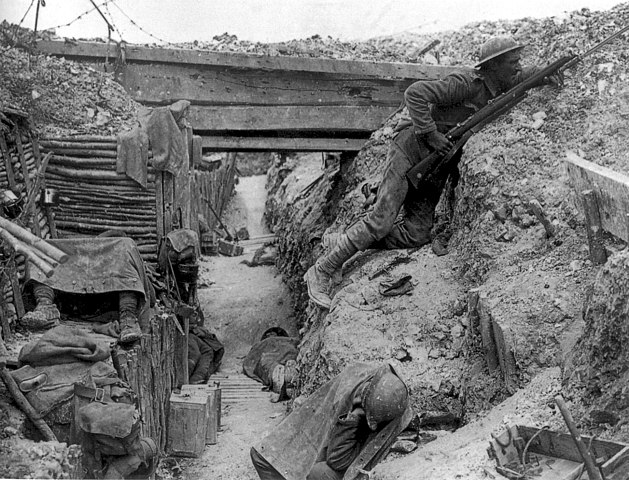
Why was the First World War fought in trenches but the Second World War wasn’t? Amongst many other reasons, because in World War 1, the armies were faced with weapon technology that had advanced too far, but they didn’t have the other necessary technology to counter that.
World War 1 started on 28th July, 1914 and it finished on 11th November, 1918. In that time, 2,490 km of trenches were dug. Trenches were used in World War 2, but nowhere near as extensively as they were used in World War 1. The idea of trench warfare and “going over the top” has become synonymous with World War 1.
The basic reason to dig a trench during a battle is for protection. Trenches have been in use for as long as people have been fighting each other. It always makes sense to dig in and protect yourself from enemy fire. However, up until the middle of the 19th century really, battles could never be won if both sides were in trenches. The two armies had to meet to fight it out. This style of fighting began to change with the introduction of the rifle, but not to a huge extent to begin with. Muskets had a range of about 150 m, but they were wildly inaccurate and it took a long time to reload them. Cannons were lethal, but they also took a long time to load and fire. The cartridge bullet was invented in 1846, and reloading became a lot faster, but still not very fast. Any two armies running at each other, or using cavalry, might lose some people to rifle or cannon fire, but the two sides would be able to meet each other and fight. And this was how warfare was done.
The First World War ended up as a trench war because when the machine gun was invented, this fighting style had to change. If two opposing armies ran at each other, the firepower of a machine gun was so great there was no way they could ever reach each other. Any side that tried to overwhelm the other would be cut to pieces, as was witnessed when 60,000 people were killed on the first day of the Battle of the Somme. The armies resorted to hiding in trenches and then trying to charge at each other. They inevitably just got cut down by machine guns. Nobody knew how to change the style of warfare to fit these new weapons. It ended up being a war of attrition where the first army to run out of replacements lost. This would probably have been Britain if America hadn’t joined in.
So, why weren’t there many trenches in the Second World War? They still had to face machine guns, so what had changed? In the 20 years between the First and Second World Wars, the engine had improved dramatically. In the First World War, ordinance and supplies had to be delivered by horse and carts because no trucks could drive over the muddy land. In wars before this, the horses and carts had followed the armies, but their supplies had been fairly light. In the First World War, massive amounts of heavy armaments were needed and the horses struggled. This meant the armies couldn’t stray too far from the railway lines because then they wouldn’t be able to arm themselves, which meant they had to be static. In World War 2, trucks were more powerful and armaments could be delivered to a mobile army.
Communication had also improved. Communication in the First World War was done over static phone lines that needed to be laid. The cables couldn’t stretch too far. Any army that was mobile, would not be able to communicate with their headquarters. In World War 2, each army had radios they could use to communicate.
The airplane made trench warfare an impossibility in World War 2. In the First World War, the airplane was in its infancy. Planes were generally used for looking down on the enemy’s trenches or shooting down other planes. They could drop bombs, but not very large bombs and not very accurately. Mortars were used to hit the trenches, but they were not very efficient or accurate. By World War 2 the plane had significantly improved. If there had been static trenches in World War 2, bombers would have destroyed them. Tanks were also a reason why World War 2 didn’t have trenches. The tank was invented in World War 1 to be able to go over trenches. They weren’t very good or successful. By World War 2, they were much more powerful and better armoured. They would have caused havoc on static trenches.
However, the main reason why the First World War became a war of trenches is because once both sides were entrenched, there was no way of stopping or changing. And this is what I learned today.
Image By John Warwick Brooke – This photograph Q 3990 comes from the collections of the Imperial War Museums (collection no. 1900-13), Public Domain, https://commons.wikimedia.org/w/index.php?curid=116369
Sources
https://www.theworldwar.org/learn/about-wwi/trench-warfare
https://www.history.com/news/life-in-the-trenches-of-world-war-i
https://en.wikipedia.org/wiki/Trench_warfare
https://www.battlefields.org/learn/articles/small-arms-across-three-wars
https://www.britannica.com/technology/mortar-weapon
